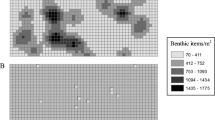Abstract
Freshwater mussels appear to be promising candidates for adaptive cluster sampling because they are benthic macroinvertebrates that cluster spatially and are frequently found at low densities. We applied adaptive cluster sampling to estimate density of freshwater mussels at 24 sites along the Cacapon River, WV, where a preliminary timed search indicated that mussels were present at low density. Adaptive cluster sampling increased yield of individual mussels and detection of uncommon species; however, it did not improve precision of density estimates. Because finding uncommon species, collecting individuals of those species, and estimating their densities are important conservation activities, additional research is warranted on application of adaptive cluster sampling to freshwater mussels. However, at this time we do not recommend routine application of adaptive cluster sampling to freshwater mussel populations. The ultimate, and currently unanswered, question is how to tell when adaptive cluster sampling should be used, i.e., when is a population sufficiently rare and clustered for adaptive cluster sampling to be efficient and practical? A cost-effective procedure needs to be developed to identify biological populations for which adaptive cluster sampling is appropriate.
Similar content being viewed by others
References
Brown, J.A. and Manly, B.J.F. (1998) Restricted adaptive cluster sampling. Environmental and Ecological Statistics, 5, 49-63.
Christman, M.C. (1997) Efficiency of some sampling designs for spatially clustered populations. Environmetrics, 8, 145-66.
Christman, M.C. (2000) A review of quadrat-based sampling of rare, geographically clustered populations. Journal of Agricultural, Biological, and Environmental Statistics, 5, 168-201.
Cochran, W.G. (1977) Sampling Techniques (3rd edition), Wiley, New York.
Downing, J.A. and Downing, W.L. (1992) Spatial aggregation, precision, and power in surveys of freshwater mussel populations. Canadian Journal of Fisheries and Aquatic Science, 49, 985-91.
Downing, J.A., Rochon, Y., and Pérusse, M. (1993) Spatial aggregation, body size, and reproductive success in the freshwater mussel. Elliptio complanata. Journal of the North American Benthological Society, 12, 148-56.
Dorazio, R.M. (1999) Design-based and model-based inference in surveys of freshwater mollusks. Journal of the North American Benthological Society, 18, 118-31.
Kovalak, W.P., Dennis, S.D., and Bates, J.M. (1986) Sampling effort required to find rare species of freshwater mussels. In Rationale for Sampling and Interpretation of Ecological Data in the Assessment of Freshwater Ecosystems, B.G. Isom (ed.), ASTM STP 84. American Society for Testing and Materials, Philadelphia, pp. 34-45.
Ricciardi, A. and Rasmussen, J.B. (1999) Extinction rates of North American freshwater fauna. Conservation Biology, 13, 1220-22.
Salehi, M. and Seber, G.A.F. (1997) Two-stage adaptive cluster sampling. Biometrics, 53, 959-70.
Smith, D.R., Conroy, M.J., and Brakhage, D.H. (1995) Efficiency of adaptive cluster sampling for estimating density of wintering waterfowl. Biometrics, 51, 777-88.
Smith, D.R., Villella, R.F., and Lemarié, D.P. (2001a) Survey protocol for assessment of endangered freshwater mussels in the Allegheny River. Journal of North American Benthological Society, 20, 118-32.
Smith, D.R., Villella, R.F., Lemarié, D.P., and von Oettingen, S. (2001b) How much excavation is needed to monitor freshwater mussels? In Freshwater Mollusk Symposium Proceedings, R.A. Tankersley, D.I. Warmolts, G.T. Walters, B.J. Armitage, P.D. Johnson, and R.S. Butler (eds), Ohio Biological Survey, Columbus, Ohio, pp. 203-18.
Strayer, D.L. and Ralley, J. (1993) Microhabitat use by an assemblage of stream-dwelling unionaceans (Bivalvia), including two rare species of Alasmidonta. Journal of North American Benthological Society, 12, 247-58.
Strayer, D.L., Sprague, S.J., and Claypool, S. (1996) A range-wide assessment of populations of Alasmidonta heterodon, and endangered freshwater mussel (Bivalvia:Unionidae). Journal of the North American Benthological Society, 15, 308-17.
Thompson, S.K. (1990) Adaptive cluster sampling. Journal of the American Statistical Association, 85, 1050-59.
Thompson, S.K. (1992) Sampling, Wiley, New York.
Thompson, S.K. and Seber, G.A.F. (1996) Adaptive sampling, Wiley, New York.
Williams, J.D., Warren, Jr., M.L., Cummings, K.S., Harris, J.L., and Neves, R.J. (1993) Conservation status of freshwater mussels of the United States and Canada. Fisheries, 18, 6-22.
Author information
Authors and Affiliations
Rights and permissions
About this article
Cite this article
Smith, D.R., Villella, R.F. & Lemarié, D.P. Application of adaptive cluster sampling to low-density populations of freshwater mussels. Environmental and Ecological Statistics 10, 7–15 (2003). https://doi.org/10.1023/A:1021956617984
Issue Date:
DOI: https://doi.org/10.1023/A:1021956617984




